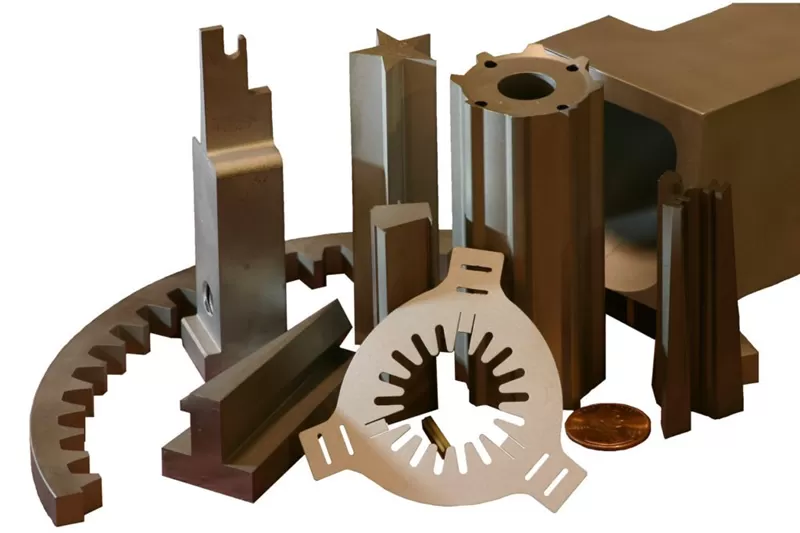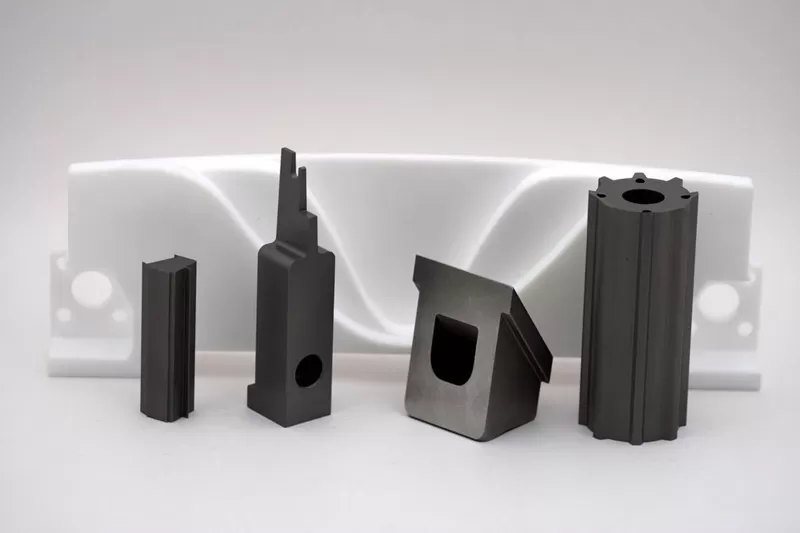EDM has two main types: traditional or plunge EDM, and wire or wire-cut EDM. As mentioned above, traditional EDM uses a tool to disperse an electric current. The tool (cathode) moves along a metal piece (anode) and melts or vaporizes the metal through the current response. Due to the dielectric fluid, usually a hydrocarbon oil, both the cathode and the workpiece are immersed in it, which flushes away the tiny debris generated during the process. Wire EDM (or WCEDM) releases charged current through a thin wire under tension, acting as the cathode and guiding along the desired cutting path or cut. In this case, the dielectric fluid (usually deionized water) flushes through the cut during cutting, once again helping to remove particles and control sparks. The thin metal wire allows for precise cuts with narrow kerfs (usually about 0.015 inches, which offers fine cuts) and tolerances of about +/- 0.0001 inches. This high precision allows for complex three-dimensional cuts and produces highly precise punches, dies, and stripper plates.
As a trusted and professional custom precision machining factory in China, our Wire EDM equipment is operated by computer numerical control (CNC) devices that can control the wire on three-dimensional axes to provide greater flexibility. Simple cuts are accomplished by changing the tool's x-y coordinates, while more complex cuts are achieved by adding motion axes to the wire guide rails. Four-axis and five-axis wire EDM machines and services are available. Traditional EDM cannot always produce tight angles or very complex patterns, but the precision of wire EDM machines allows for complex patterns and cuts. Additionally, wire EDM can cut metal materials as thin as 0.004 inches and thicker than 16 inches. In routine cases, there may be thicker sections. At certain material thicknesses, wire EDM will vaporize the metal, removing potential debris. The wire in a WCEDM device sparks on all sides, meaning the kerf must be thicker than the wire itself. In other words, since the wire is surrounded by an electric current ring, the smallest and most precise cutting path may be the added diameter of the ring and the wire; technicians can easily interpret this added size. Manufacturers continue to produce thinner wires for smaller kerfs and higher precision.

Due to its versatility, manufacturers can use wire EDM machines for a wide range of applications. Because this process can cut very small workpieces, it is often ideal for producing small, high-precision parts that are usually too delicate for other machining schemes. Moreover, this process is cost-effective for producing small-batch projects, and it can also prove beneficial for prototype manufacturing even if actual projects are conducted differently. It is important to remember that the wire continuously moves during machining and cannot be reused. Therefore, copper, brass, or other metal wires can be miles long, increasing the process cost. Furthermore, although the process does not use any force and therefore does not produce burrs, making it suitable for fragile items, the possibility of thermal stress definitely exists. Most machining operations involving wire EDM start with roughing, which has a fairly fast feed rate and high dielectric constant. Continuous skim passes use smaller kerfs, reducing dielectric fluid flow to achieve a finished surface to tolerance. Reduced dielectric flow prevents the wire from deforming during these skim passes. Cuts that do not start along the part's edge (such as holes) require pre-drilling to allow the wire to pass through. Many wire EDM machines are equipped with electrodes for small hole drilling, allowing starter holes to be machined in hardened steel without using conventional drills. Small hole drilling usually uses an EDM electrode mounted on a rotating spindle, with the dielectric fluid pumped through the electrode to flush the hole. The process of using a separate EDM drill to create small holes in hardened materials is sometimes called splicing.

Compared to traditional EDM machining, the main advantage of wire edm machining services is that the continuous power supply minimizes wear on fixed electrodes. Wire EDM machines consume a significant amount of wire, which correspondingly increases the cost. Many wire EDM machines are self-threading, so even if the wire breaks, the entire machining process can continue almost uninterrupted.
Another major advantage is the ability to cut parts after heat treatment, eliminating the possibility of deformation caused by post-processing after machining. Additionally, because the wire EDM machining method does not apply any machining pressure to the workpiece, it is easy to machine small parts. Compared to traditional machining methods, the requirement for fixtures is minimal. Very fine surfaces can be machined.
